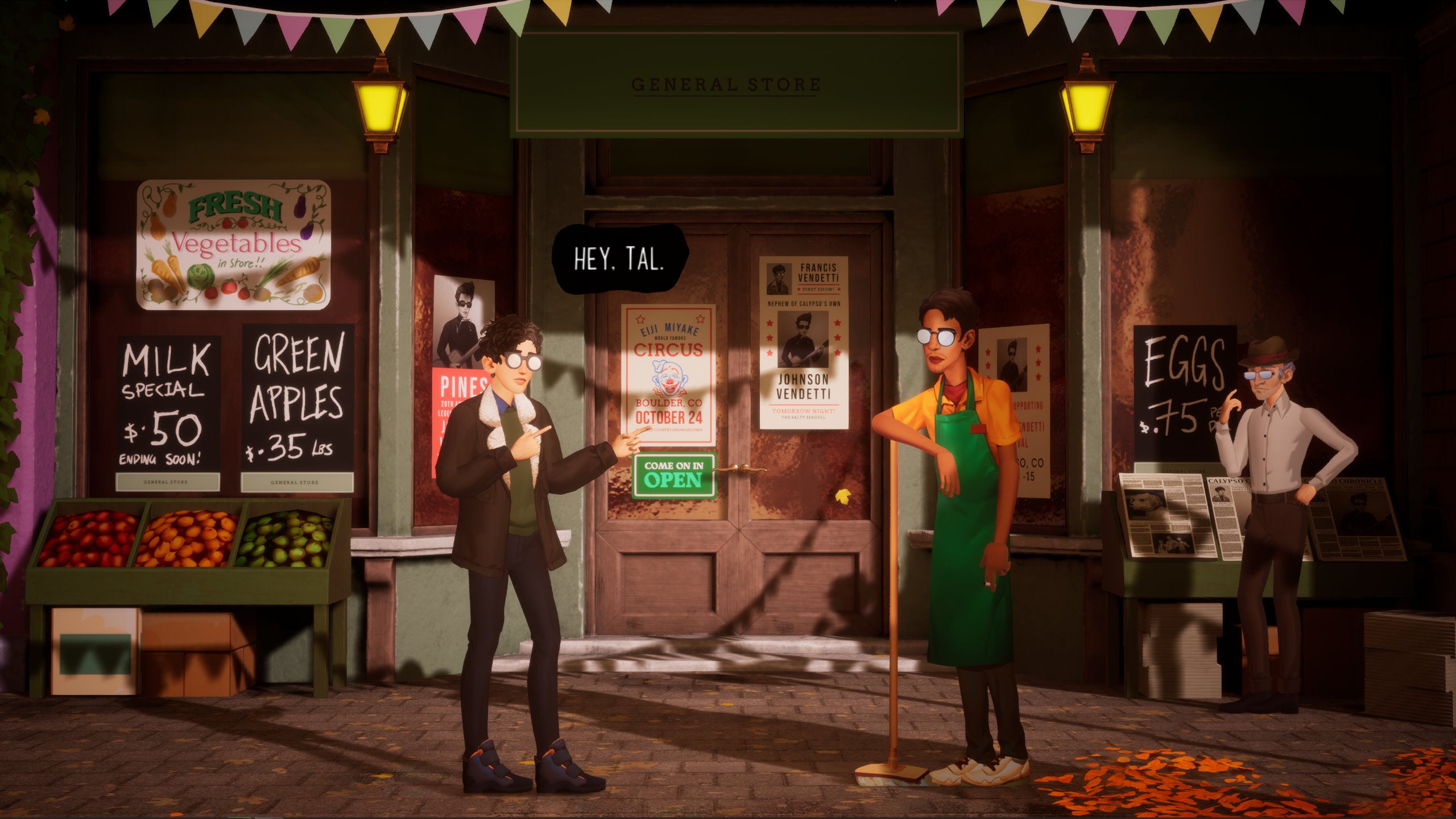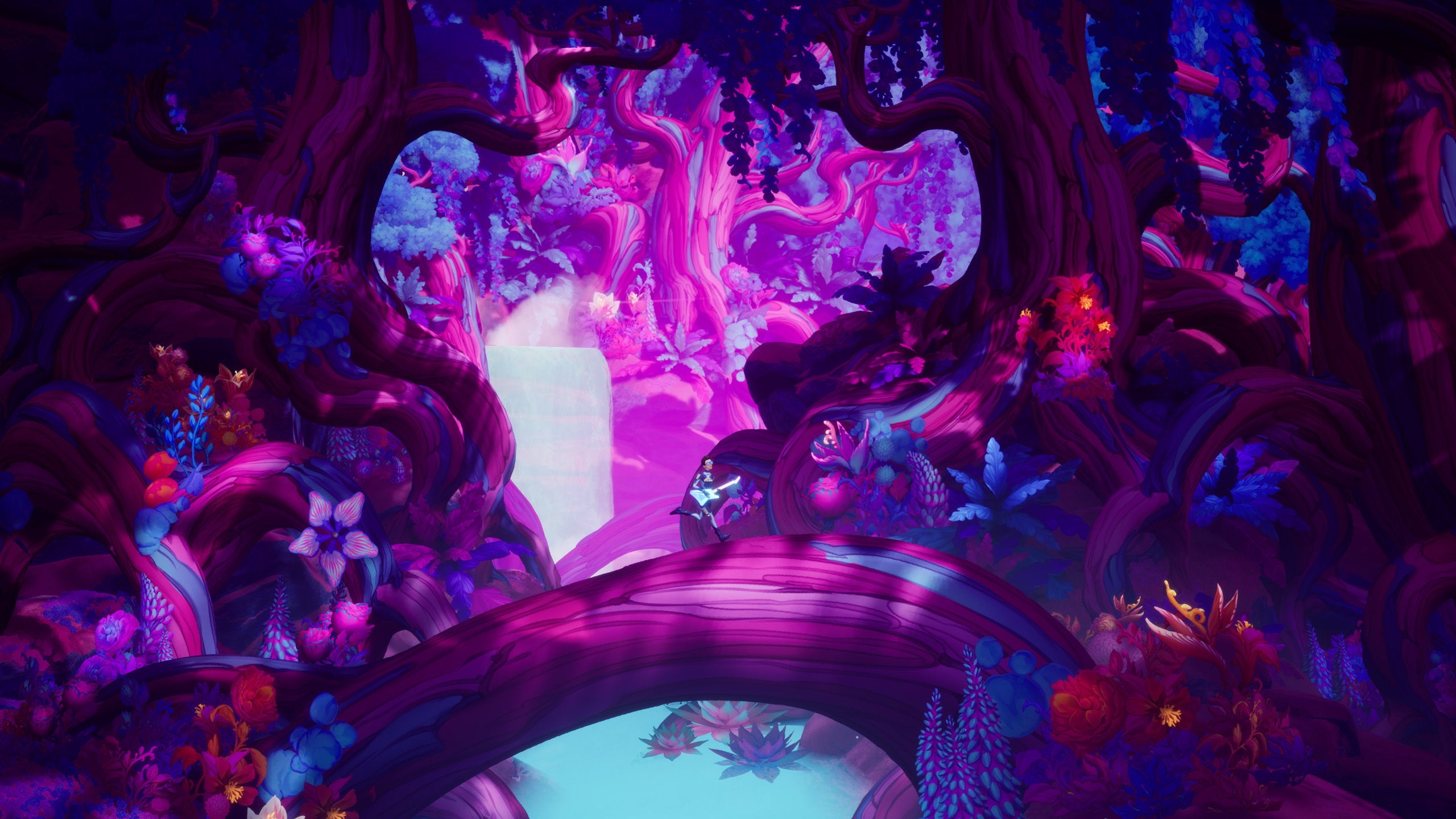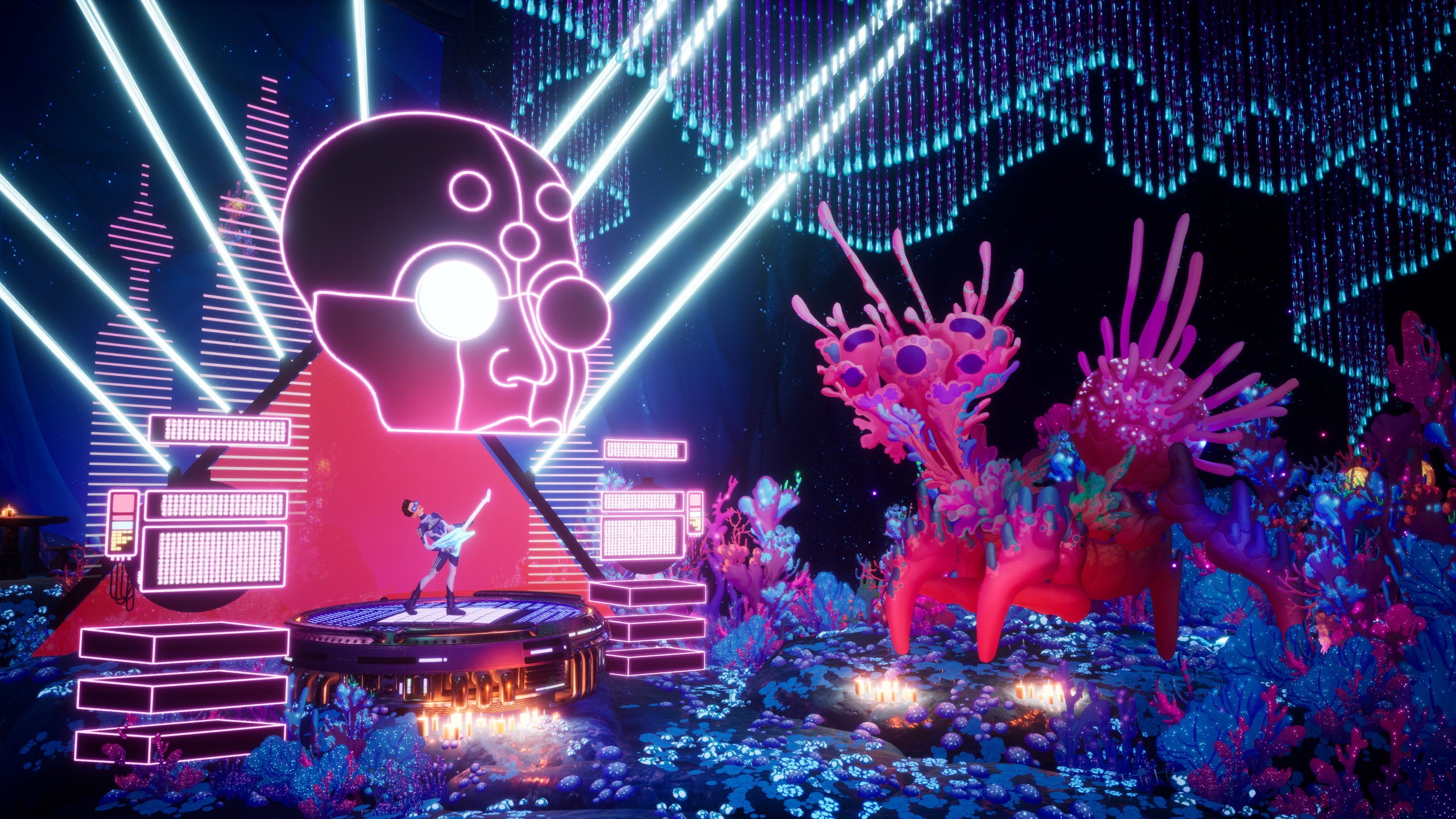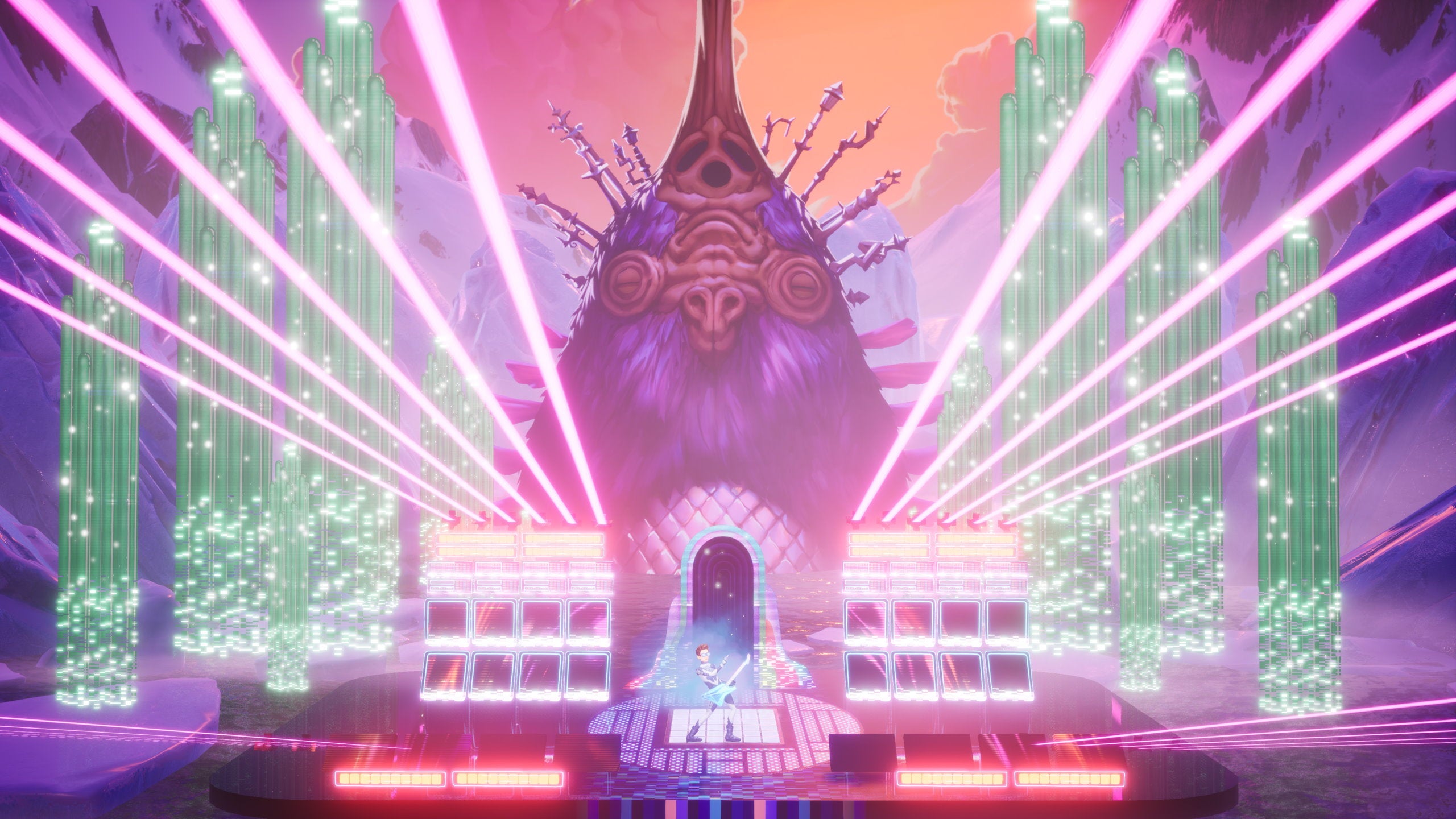“Superbrothers: Sword & Sworcery EP really made me want to make an indie game for iPad,” he tells me, “[while] Kentucky Route Zero pushed me into the mindset of making something for PC. And, look, things spiralled out of control and here we are.” Indeed, as we found out yesterday during Annapurna’s Interactive Showcase, we’ll finally be able to power slide through the final version of Galvatron’s psychedelic romp through the heavens when it comes to PC on September 9th. Galvatron describes the game as, “kinda like if David Bowie went on a space journey and came back as Ziggy Stardust,” and you can see it right from the get go. While my hands-off preview session started in the idyllic fictional town of Calypso, Colorado, where young musician Francis Vendetti is struggling to find his voice on his juked up guitar, he immediately gets the rug pulled from under his earnest strums by a mysterious woman called Violetta. Replete in bright purple shades, and a purple and ethereal blue jacket, she’s a stark contrast to Francis’ try-hard folk look. But her words and unabashed confidence strike a chord with Francis, and what follows is probably the maddest, but most joyful journey of self-discovery ever committed to video games. It’s when Galvatron fast forwards to an area known as The Heliotromms that The Artful Escape really comes alive. It will be a familiar sight to anyone who pored over the game’s first reveal back in 2017, but whereas that version’s art was pulled together by Galvatron himself - “a mistake,” he says in hindsight - now its intergalactic hillsides have been redrawn by illustrator Arden Beckwith, whose “serious chops” Galvatron says made him “realise [he’s] just a shadow stumbling in the dark.” As Francis emerges from a cave into a forest bathed in purple light, we find he’s shed his dark, fur collar jacket for a bright blue, almost Mega Man-like space suit studded with LEDs and raised muscle pads. Violetta hovers above him as an even brighter hologram, beckoning him to head east and find a creature called “StarGordon” - and if that doesn’t give you an idea of where this game’s heading, then the next few moments certainly will. Crunching across the snowy undergrowth, the canopy suddenly breaks to reveal a huge piercing moon cresting a vast planet in the distance. Snowcapped mountains pierce the sky around it, and the moonlight glistens on the ice beneath your feet. All the while, the music is swelling in the background, and when Galvatron hits a button on his controller to whip out Francis’ guitar to start shredding, it feels like the most natural thing in the world as he runs and jumps across this impossible landscape. “You can shred anywhere you want,” says Galvatron. “Each world is in a different key, and we made sure that when we were recording the guitar and the different bass lines, that anything played anywhere works. We get a lot of comments from people saying it must be hard to record the guitar the whole way through and line it up with the music, but that’s actually not what’s happening. It’s just written in a way that it should be interchangeable and kind of amorphous. It’s a kind of Dark Side Of The Rainbow thing. It’s your brain associating this kind of shredding with the moments and the music behind it and it’s your brain that really brings it all together around the musical theory.” The guitar playing isn’t just there for style points, though. You’ll also be using the guitar to give you an extra boost to leap across large gaps, knee-slide down huge rolling hills like you’ve suddenly stepped into a psychedelic version of Alto’s Odyssey, as well as slam it into the ground to activate switches and, in the case of The Heliotromms, turn on little museum stations set up to immortalise the planet’s resident rock star Lightman (who will be voiced by Carl Weathers). It’s possible to mess jumps and slides, but Galvatron assures me the game just “zooms you back” to try again. “The music doesn’t stop or anything. It’s not that kind of vibe.” There are also the big, boss battle-esque jam sessions. Alas, I didn’t get to see one in action during my preview session, but these call-and-response sequences are all set in their own musical key consisting of five notes, says Galvatron, and they sound properly mad. “One’s like a crazy fish bird monkey monster that flies up through space and you chase it and jam with it,” he says. “They’re really big musical set pieces that, musically, were extremely difficult to design, […] but I’m really excited to see what people think of those. I feel like we’ve arranged the call and response jams in a way that feels very powerful.” Again, it is possible to get these wrong in the moment, but the only repercussion you’ll face is a disgusted bristle from your fellow jammer. “You do need fail states, because you want people to have some challenge with your platforming, but it doesn’t really lean on that stuff,” says Galvatron. From the sound of things, though, the jam bosses are just the tip of the iceberg when it comes to the electrifying concoction of sights and sounds Galvatron has in store for us. On the music side, he tells me that each area of the game will have its own distinct musical tone, which will morph and change as the game goes on. “The Heliotromms is that real, like, Bill & Ted vibe, and then in the world you go to next, there’s less distortion, more ethereal, more David Gilmore, kinda Pink Floyd. Then it goes a little crazier in one of the last worlds where it’s like Talking Heads.” As for the “artful” side of Francis’ escape, Galvatron’s descriptions have me itching to see them in the flesh. The Heliotromms comes in the middle of a region known as the “Crazy Cosmic Extraordinary”, and Weathers’ character Lightman runs a club known as the Cosmic Lung, “which is like a stolen Austrian opera house in a breathing piece of coral that floats around in space,” according to Galvatron. Meanwhile, the museum pieces you encounter are read out by his Jason Schwartzman-voiced first mate, who is “a floating brain in an aquarium atop a flotilla of goldfish fins”. It’s heady stuff, but Galvatron’s confident that his hours and hours of recorded music will be more than an equal match for what you’ll see onscreen. “We made way too much music,” he laughs, admitting this is partly the reason why the game’s taken so long to finish (that, and “learning how to make video games,” he adds). “[The music] ranges from everything like big symphonic stuff all the way down to terrible jazz. We [also] recorded a whole folk album [for the history of the game and Francis’ famous uncle], we used every kind of synth that I can think of… It was an example in excess. It was like Def Leppard in the studio in the 80s, just taking ten months to do a guitar solo. Don’t tell Annapurna that!” No doubt about it, Galvatron’s enthusiasm for the game is infectious, and everything I saw and heard during my preview session has left me crying for an encore ahead of its final release. Of course, if you were to don your big skeptic shades for a moment, it’s entirely possible that The Artful Escape’s intoxicating ambition may end up collapsing in on itself. 30 minutes of hands-off time with the game just isn’t long enough to make a proper call on it, and I suspect the strength of its underlying story of self-discovery, chasing your dreams, and overcoming your own moments of personal stage fright will be key in making this escape a truly great one. At the same time, I do believe Galvatron and his band of “mavericks, renegades, criminals, bakers, dancers, moonwalkers [and] wearers of large scarves” (yes, really) have something special here. “The way the music works in The Artful Escape, the way the world flies by and the universe is at the whim of your fingertips, that’s what happens in my head when I’m playing music,” says Galvatron, and if this early glimpse into his operatic galaxy brain has taught me anything during my time with The Artful Escape, it’s that this is one act you won’t want to miss.




